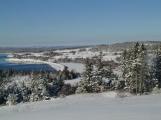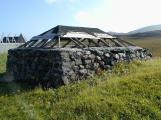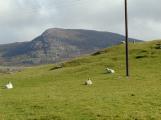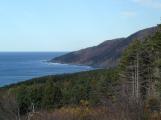2
When searching for the Gaelic language and Gaelic people, we are really following the trail of oral history, songs and long narrative tales passed from generation to generation. The Scottish Gael makes up one of the largest ethnic groups in Nova Scotia. Nova Scotia Gaels came from the Western Highlands and Islands of Scotland between the end of the 18th century and the middle of the 19th century. Peak immigration ended for Cape Breton about 1840. It is estimated that 30, 000 Gaelic speaking Scots landed in Cape Breton Island in that time. The exact number is hard to define as no clear records were kept of ships' passengers who landed here nor were all name census done in Nova Scotia until 1871.4
Gaelic is a Celtic language and belongs to the Goidelic or "Q" Celtic family. Irish, Scottish and Manx Gaelic belong to this family.5
Common Gaelic sayings translated to English12 July 2006
Iona, Victoria County, NS
 Credits:
Credits:James Watson & Joanne MacIntyre
6
Verses composed by Donald MacLellan, Mira in Gaelic and English1820-1880
Mira, Cape Breton County, NS
 Credits:
Credits:James Watson & Joanne MacIntyre
8
The early history of the Gael begins in the last days of the Roman empire. They produced prose, law tracts, histories, genealogies and many more subjects all written in Gaelic. This continued until the age of the Vikings. The kingship of the Gaels gradually came under the influence of the English south and became anglicized. There was still some support for learning but not to the same extent. By 1603 the education system had been destroyed by attacks from Tudor England and the collapse of Gaelic Ireland. Many Gaels had gone to Ireland to be educated in the language.10
The 17th and 18th centuries continued the breakup of Gaelic Society. Patronage for the Gaelic arts was ended when the clan system was destroyed. With those relationships gone, the people were turned into tennants with basicly no rights. The people were cleared from the best lands to make room for sheep which could make more money for the landlords. Some were sent away and others moved to poorer lands closer to the shore. They were still expected to raise the rents from land that barely supported their family. It is no wonder that the Gael began to think of leaving the Highlands.11
Cape Breton map showing the areas settled mainliy by Gaelic speaking people1800-1850
Cape Breton Island, Nova Scotia
 Credits:
Credits:Pauline MacLean
12
The late 18th century began the Gaelic settlement in Nova Scotia. Soldiers who came to North America brought the news of land back to their families. Accounts demonstrate that some early emmigrants chose to leave and arranged passage for others. These first settlers, often from the tacksman class, were educated, so-called middle class settlers. Gaels emmigrated in family groups with close friends and neighbours as part of the group. They had the intent of recreating their community in the new land.14
Cape Breton in winterCirca 1991
Jamesville, Victoria County, Cape Breton, NS
 Credits:
Credits:Rodney Chaisson




